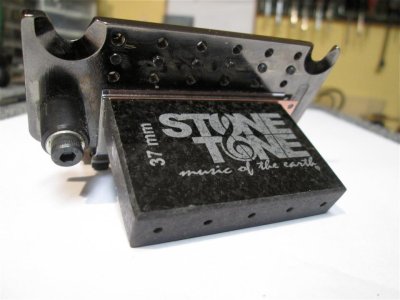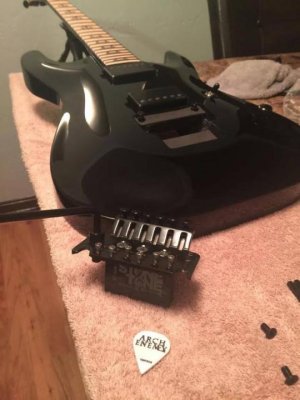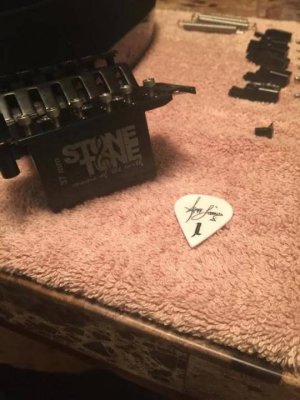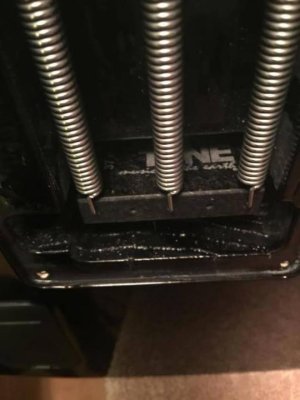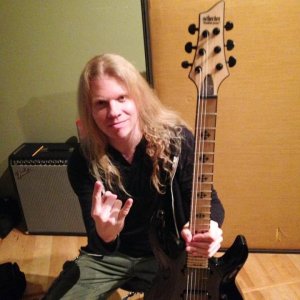Sounds intriguing, but at $120 for a trem block I think I'll just turn up 30%. I'm sure if Floyd Rose is actually endorsing it, it has some merits, but that's a lot of dough for working musicians to pay for a block, vs the cost of other blocks.
Leon, I understand your concern about the price but for what it does, you can't lose even if you we're the only one that didn't like it for any respected reason you would be the first.
From a engineers perspective, I'll post 2 quotes from players that build amps which 1 is very well known Globally, and the other is a locally known builder in California with a excellent reputation.
--------------------------------------------------------------------------------------------------------------------------------------------------------------------------------------------------------------------------
I finally had the chance to gather my thoughts about the new Stone Tone block you sent me for my G&L. I've got a few rehearsals and real gigs behind me to get a feel for the guitar with this important change in place. I'm impressed and clearly other players who heard the guitar heard this as well.
For reference: I have owned my G&L Musical Instruments Legacy Strat style for about 15 years. I know it downright intimately as a result. It's been through a new paint job (or two), and two pickup swaps: The stock pickups were pretty low output and lifeless. The early G&L pickups were known to be like this. The later ones I understand are better. Despite that, the tone, balance and playability made the guitar a keeper and pickups are easy enough to change. First I installed Di Marzio Virtual noiseless pickups, which I used for about ten years. They were very good: quiet and healthy output but didn't "quack" like a Strat should and were quite a bit warmer than a true Strat tone really should be. Eventually I discovered my current Zexcoil Guitar Pickups. These are silent, can be tapped and remain silent, and sound excellent. I have to say, I was more than skeptical when you approached me with this idea for a stone block.
Like anything so radical and "different" I was leery of switching something as important as my trem block, but I've always been curious about it since a number of companies have clearly made some high profile businesses making blocks of various metals. When I received your block, the first thing that surprised me was how light the bridge assembly became ! The differences between the old steel (?) stock block and the stone block was pretty shocking ! I installed it and strung up the guitar with my go-to string the standard D'Addario Nickel 10-46 set.
The first thing that struck me was the much louder unplugged acoustic tone. It was clearly louder but also more focused and clear. [Like many, I believe the acoustic properties of an electric guitar clearly reflect how good that guitar will potentially be when amplified electrically.] The Stone Tone block did not disappoint. The better qualities that made this my "#1" S-style were still there: Plenty of long sustain, easy controlled feedback and note-ring plus the distinctive sound a good Strat should have, but there was certainly much more: The guitar was (for lack of a better description) more "hi-fi". It seemed to respond quicker to a pick attack. I think there might be maybe a shade less low end warmth than the old block, but the trade-off to an overall greater detail to my sound and a more clear harmonic structure and clarity are well worth that subtle shift.
There also seems to also be a clearly wider dynamic range when you pick lightly or more aggressively. Like a high quality amp, it certainly makes a player more aware of trying to be a better and more accurate player. Some guys need "forgiving" equipment to cover their sins. I prefer to try to improve my playing when my gear puts me under a microscope.
SO in conclusion: The quality of this block is not only excellent sonically but in terms of how well it's executed: As the son and grandson of German machinists I can appreciate quality machine work. The block displayed high quality accurate machining throughout, a super flat surface to contact the bridge plate, and the sides were polished professionally and smoothly. All the bridge hardware fit properly without issue.
I used copper braid, which I put under the collet that the tremolo arm goes into for attaching my ground to the wiring, since the block is non-conductive and you cannot use the trem claw to connect your ground any longer. This is a minor modification any good guitar tech should be able to do when installing the block. The block also doesn't have those recessed holes where a string end usually goes. Initially I thought this was odd, but actually realized it's more convenient when a string breaks than trying to fish out a stuck string ball !
Overall, I really am pleased with the block and recommend it as an excellent enhancement to anyone wanting to take their guitar up a notch in tone !! Kudo's Robert, well done.
"I wish it was easy to put the old block back and show the differences. All I know is "screw vintage" this block has made this the finest sounding Strat I own and that many ever heard".
- Andy Fuchs
http://www.fuchsaudiotechnology.com
-----------------------------------------------------------------------------------------------------------------------------------------------------------------------------------------------------------------------
OK, so I got the block into this Ti Floyd, put the guitar back together and set it up...
I'm gonna be honest here and say that as a scientific kinda guy (electrical engineer), I was pretty skeptical about the science behind this block and I really wanted to prove that it was just a way to get people's money. Obviously, I have no relationship with the company whatsoever...
Well... regardless of the actual science, the bottom line is that my subjective opinion after playing with and without plugging in for awhile is that this block has made the MOST significant change to my guitar than a block of any other kind, and I've had the big brass ones and the Ti ones. Without plugging in, the whole guitar vibrates in your hands so strongly when you strike a chord, it is almost disturbing. The body does the same thing under your right arm. It feels like it's ALIVE or something... Based on my testing, both chords and single notes sustain MUCH longer than with the previous Ti block. And remember, I'm testing a 42mm Ti block against a 32mm Stone block. The Ti one is way longer and heavier. When I plugged in, the guitar sustained much longer as well and it sounds "throatier" for lack of a better word.
I have no idea how this is going to translate to a recording. Truthfully, I expect the difference will not seem like much, but I'm going to play the same exact things as the previous clip and record them the same exact way to see. One thing that is undeniable is that the guitar FEELS much different - the vibrations of the strings through the body and neck are unbelievably stronger. I dig that feeling a lot, but it's weird at first. I compared it to my white relic strat guitar that has a big brass block and it is night and day - the feel of the vibrations with Stone block are way stronger and the guitar felt exactly like the white relic strat with the Ti block.
The guitar is louder in two ways:
1.) Acoustcally. Sitting in the room, the guitar is way louder with this block than the Ti block when it is not plugged in. It is louder than my guitar that has the big brass block as well.
2.) Electrically. When the guitar is plugged in, with the amp settings the same, the output of the amp is louder. When I mic'd the tracks into my DAW, you could see the waveforms were larger and the tracks hit higher on the meter with the Stone block and NO changes to the amp settings or anything else at all. When I was mixing, in order to match the output volume of the previous clip, I had to bring the faders down a significant amount on the newly recorded tracks with the Stone block.
So, because the guitar is louder acoustically with the Stone block, the pickups are generating more output, driving the amp harder (more input to the amp), resulting in more volume output from the amp for the same settings. More input to the mic, mic pre and tracks with no changes to the settings on the amp. So, yeah, more guitar volume output to the amp...
BTW - When I was mixing this on both the heavy and the clean I had to bring the faders down a couple dbs on the tracks to match the volume on the original titanium block clips. So the guitar definitely gets louder with the Stone block... The clean sounds "chimey-er" to me as well.
Based on my testing, I'd say that for sure it makes the guitar louder acoustically and louder through the amp and it makes the guitar body and neck vibrate like crazy compared to a Ti or Big Brass block. The enhanced vibration makes the guitar feel really alive and is really cool once you get used to it. It also sustains better for sure in my guitar. It sounds throatier and chimier than a Ti block - For me it is definitely worth $35-40 more than a Ti block...
- Steve Henning
https://henningamps.com
